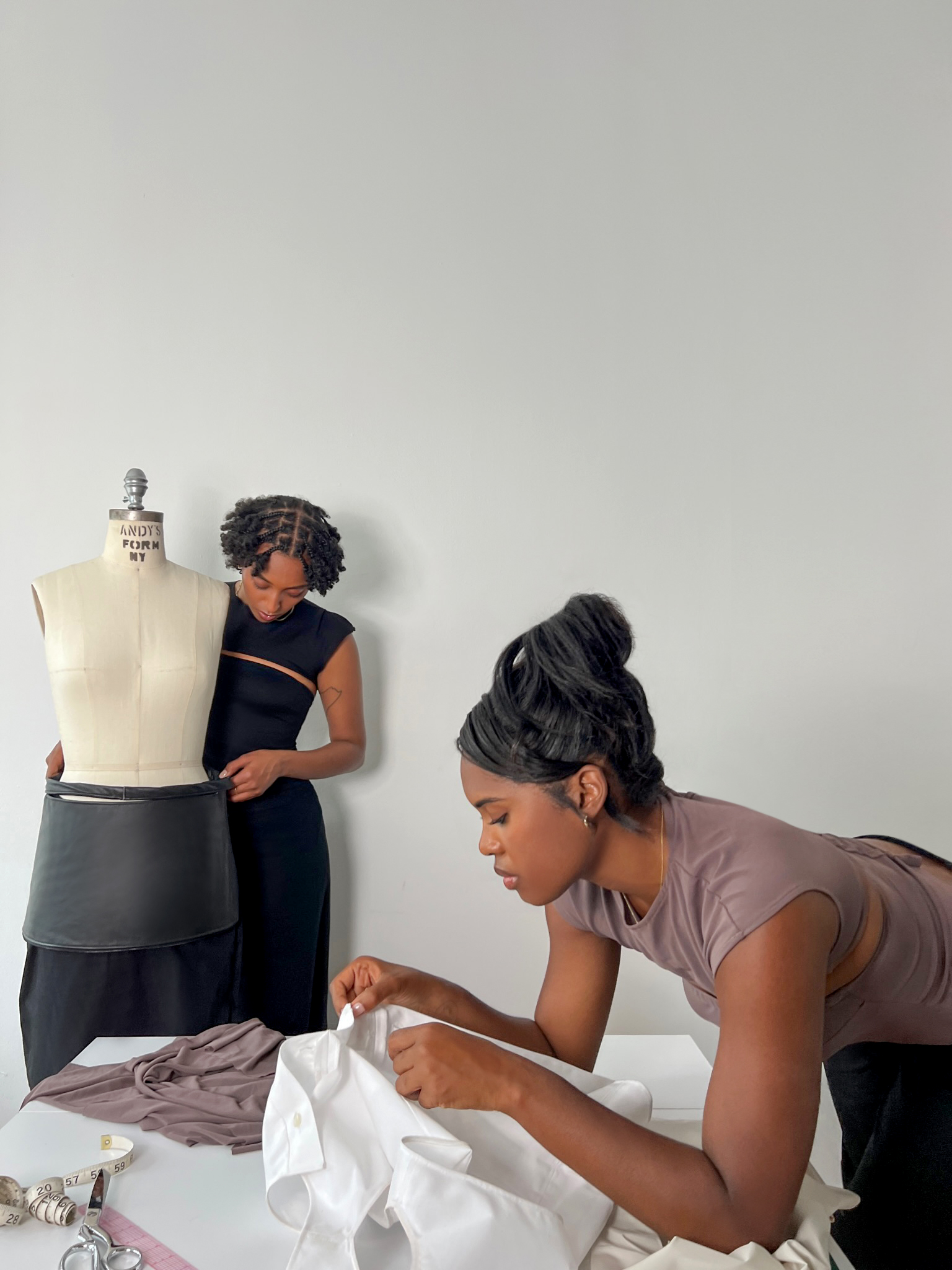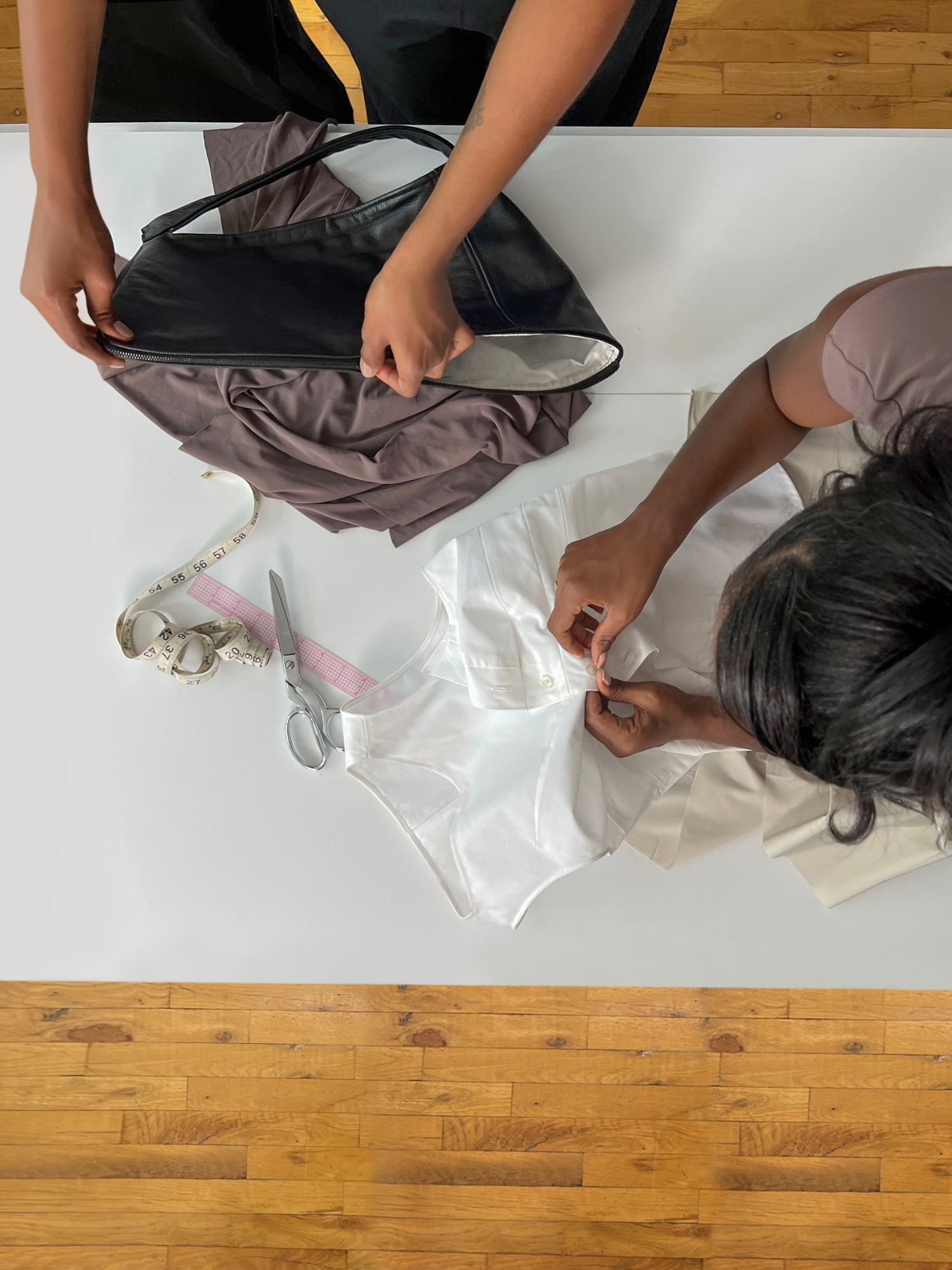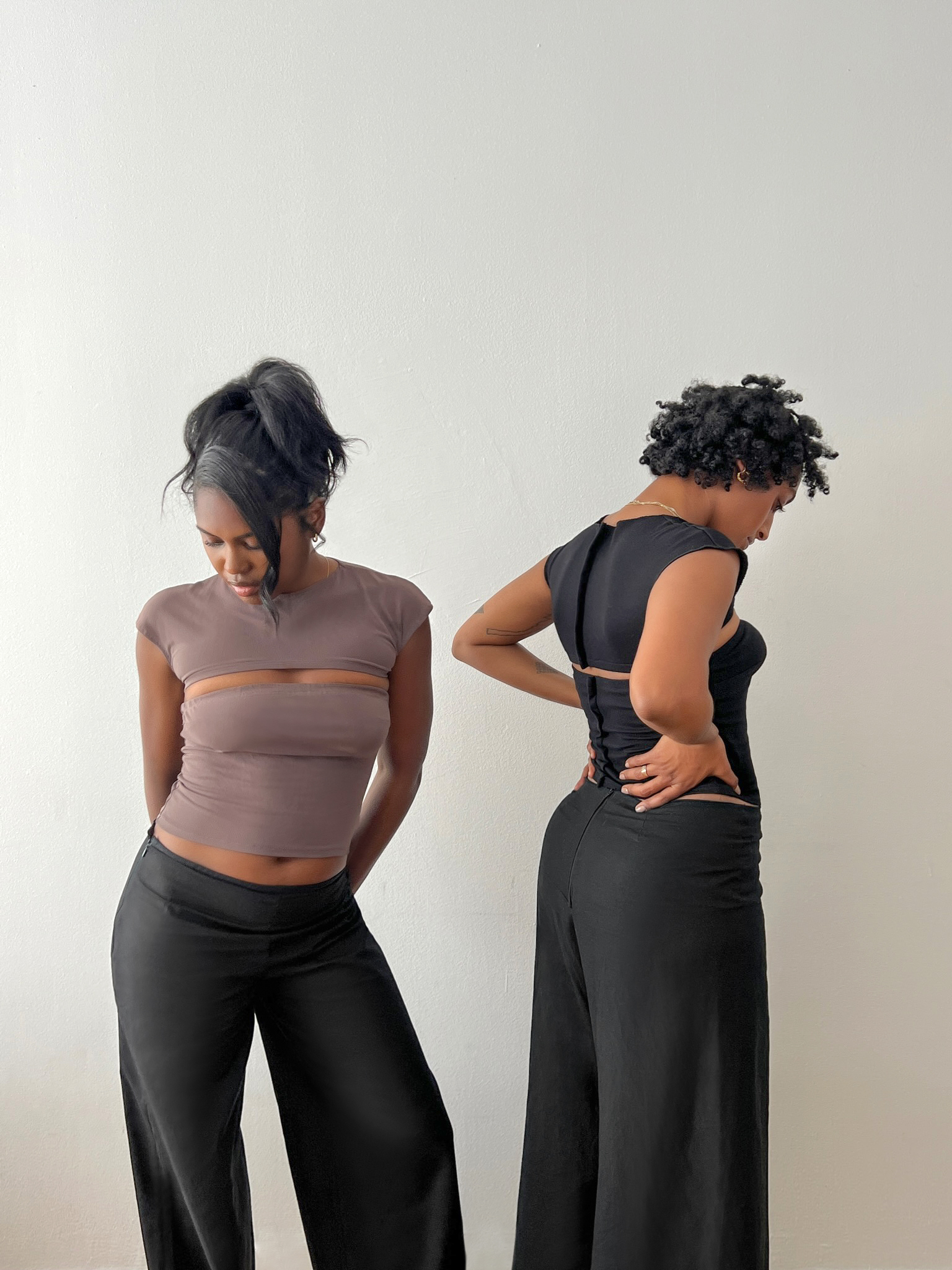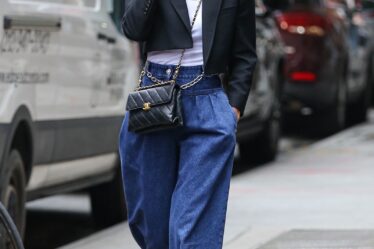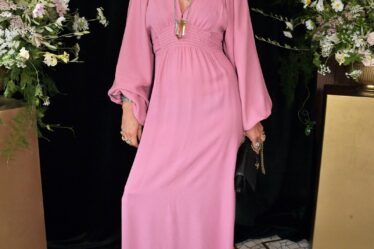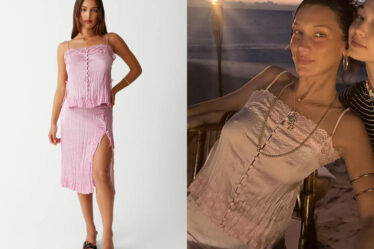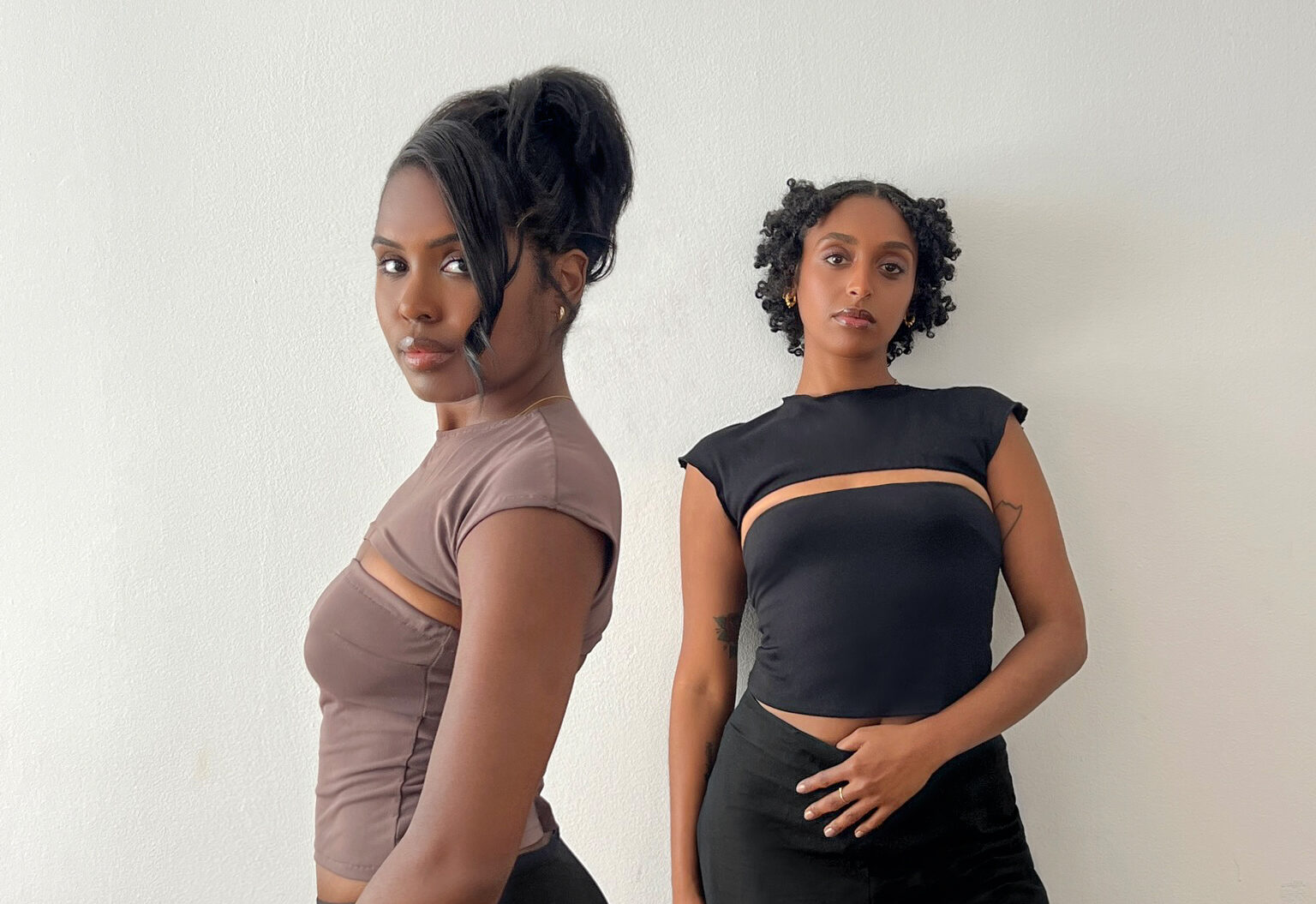
Banna Nega and Shelby Macklin are not here to make clothes that won’t be worth wearing the following year or season. They are the antithesis of everything quick and easy. The collaborators, who met in an entrepreneurship class at LIM college, want to build a genuine connection with every customer who walks through the doors of Glazed NYC, a boutique specializing in vintage-inspired pieces, and the repurposing of them. At Glazed, located in Greenpoint and founded in 2015, each article of clothing or accessory is hand-made in the store, made to be timeless and durable, with an individual in mind.
“When you think of a glaze, it’s the final finishing touch that ties everything together,” says Nega. “And we felt like that’s what our pieces did for your look.” Their newest drop, released last month, features six items: two great layering tops, three solid black bottoms, and a bag that can transform into a skirt and back at a moment’s notice. Earlier this summer, the dynamic duo caught up with us to explain the origins of Glazed NYC, their bespoke process, and designing for “the New Yorker on the go.”
———
MICHAEL-MICHELLE PRATT: How did you two first meet?
BANNA NEGA: Shelby and I actually met in entrepreneurship class at LIM College. We were roommates when we started Glazed, which happened out of necessity because it was the polar vortex. It was super cold and we felt like we weren’t able to stay warm and also feel cute, that intersection of functionality and glamour. So that was the inspiration behind our first collection.
PRATT: What sparked that idea to collaborate?
NEGA: Shelby is the visionary and I’m more of a “details” person, so Shelby had the idea and brought it to my attention. We wanted it to speak to daily life in a city like New York, where no matter what the weather is, you have to be on go. So we just put our heads together and identified what our roles were.
SHELBY MACKLIN: Banna is also an incredible archivist. For our first meeting, she had a whole presentation of inspiration we could pull for Glazed and what the branding could look like. That just made me even more inspired because not only was it this problem that we were uncovering in the present, but we were able to use the past to assist us in paving the way now.
PRATT: Banna, how did you become interested in archiving?
NEGA: I think I’m just really fascinated by history. I’ve always been interested in what has come before us, and I am a nostalgic person as well. I’m really into family photos and family history. But we also both understood that we’re not creating something that’s never existed before, but we’re being innovative and retelling stories through our modern understanding.
PRATT: What void are you trying to fill with this new collection?
NEGA: It’s hard to ignore the amount of waste created by the fashion industry, especially having worked in fashion for 10-plus years. It’s jarring and it can feel hopeless. But we choose to look at what is in our power to manifest the change that we want to see. Being the antithesis to fast fashion is at the core of our ethos, even with how we treat our team. Historically, there’s a void when it comes to actually treating people with respect [in the fashion industry]. Shelby and I are really empathetic and connected people and that’s something I really love about us as a team because it’s very natural for the both of us.
PRATT: I’m curious, how did you come up with the name Glazed?
NEGA: We started with accessories. So when you think of a glaze, it’s the final finishing touch that ties everything together. And we felt like that’s what our pieces did for your look.
PRATT: I love that. How is your own style reflected in the work that you’re doing?
MACKLIN: I can answer that one. Glazed has always been for the New Yorker on the go. So we always have the day-to-night look in our mind because when you step out in New York in the morning, you do not know when you’re coming back home. You could plan on just going to work, but you meet a friend after work, and next thing you know you’re going to a party, next thing you’re going to an afters. And you want to be able to feel confident the entire day as you’re switching through these different spaces. But also we needed to create a timeless style that’s not trend-driven. So it’s not just about summer 2023. It’s this collection you could wear—
BANNA NEGA: All year round.
MACKLIN: For the rest of your life. That’s another way we’re extending the life cycle of these pieces. They’re seasonless. These pieces are meant to be reworked too, so it’s coming from an existing garment that you’re not using. We’ll assist you with extending the life cycle of your own garment in your closet or use deadstock or sustainable fabrics that we source.
PRATT: I love that you all mentioned appealing to a variety of clothing styles. How are you differentiating yourselves in giving people a comfortable space with fashion?
NEGA: We’re tapped into our community and actually listening to people. Like we’re collecting data in focus groups. And we’re going to be more B2B, so we’ll be working with other stores and vintage shops that are in alignment with our ethos and reworking their leftover products that would otherwise go to waste. A lot of people are just sitting on excess inventory, and they end up marking it down to the point where they’re not making anything off of it, or it goes to waste.
MACKLIN: Yeah. It’s real collaboration. Each of our designs will also have digital products coinciding with them, which is another way that we’ll collaborate with our community, especially for the people who aren’t based in New York. So you could download a digital pattern of a design and rework pieces in your own closet. And you would have your own Glazed piece, even if you’re not able to come into the studio or you don’t want to order online.
NEGA: We’ve never been gatekeepers or had a scarcity mentality. We’ve seen a lot of trends, especially on TikTok, of people getting into DIY. So it’s exciting to give people another creative outlet.
PRATT: How did the collaborations with other vintage stores come about?
MACKLIN: Honestly, it happened naturally. I was just out shopping one day—
NEGGA: Well, we’ve been doing that.
MACKLIN: Yeah. We shop. We’re out here. So we’ve connected with a lot of different shops personally and just asked them if it would make sense. And it does make sense. New York is a hub of the best fashion shops and vintage shops in the world.
NEGA: And we’re able to tailor the experience of our designs and our collection to each person that we work with. We’ve collaborated with The Break for these berets that were only sold at their space.
PRATT: I really appreciate that it seems to be a passion that you have to find solutions to make people’s lives better.
NEGA: Thank you.
MACKLIN: Yeah, it was honestly gratifying, especially having the studio last year, for people to bring in garments that could be family heirlooms and trust us to extend their life cycle.
NEGA: Oh, yeah. I could cry thinking about that.
MACKLIN: A lot of times people don’t understand what it takes to develop even a r-shirt and it gives you a new respect for what you’re wearing on your back.
PRATT: You said there were moments that made you emotional working with different clients. Have you been intentional on making a safe space for Black women or clients in general?
NEGA: We just care about people on a personal level. And clothing is so personal and vulnerable, especially for women. So we have to be loving in this. The love that we have for our team, for the folks that come in and share their stories with us, for everything that we do, it shows.
PRATT: Tell me about the process in creating the Glazed Studio Collection.
MACKLIN: We were thinking of the problems that we’re seeing with basics. “What can we do to advance the tube top?” We’re looking to push the envelope on what a capsule collection could look like and scale it through Glazed where it’s accessible in all these different ways. We wanted this collection to be versatile in terms of design and also versatile in terms of body types. We wanted to create something new with this. We didn’t want it to just be your typical collection.
PRATT: So wanting to be innovative, how did you pull from references while ensuring that the collection was really new and fresh?
MACKLIN: We had a bunch of really in-depth meetings with our design team where we all pulled references of different basics and we would discuss what we liked or didn’t like. There was a lot of thought that went into it.
NEGA: We have done a vintage rework capsule collection before and still honored the integrity of the garments. But with this, we’re really stripping it down and putting it back. It doesn’t always have to look thrifty or vintage. It can look like a brand new piece that you bought at the store and still be sustainable. But it’s not an intricate piece. They’re basics that you could literally wear as a uniform. No one’s going to clock you and be like, “You wore that vintage shirt two days ago.”
PRATT: What made you want to disrupt the model for fashion with Glazed?
MACKLIN: To be honest, keeping up with it was not sustainable for us. The budget that you need to have to produce the amount of collections to keep up with the fashion calendar is just insane. It’s not meant for just anyone. There’s so many rounds of sampling, there’s real steps behind it. And fast fashion, they’re just flushing out clothes. The amount of waste just wasn’t something that we wanted to participate in.
PRATT: How does that reflect on the customer’s experience?
NEGA: We want them to rethink the experience of buying clothes. A lot of it is rooted in rushing and chasing the dragon, and it’s important for us to take time to think and be intentional about it.
MACKLIN: So we’re creating a shopping experience for the modern customer who actually cares about where they’re investing their money and how they’re presenting themselves. And our team is all paid fairly. Our pieces are made with love from local designers in New York.
NEGA: Actual technical design experts.
MACKLIN: We’re connecting with the energy that we’re putting out.
PRATT: What feels different about this collection to you?
MACKLIN: In the past, we were creating around concepts that we were feeling at the time. It was more expression with less intention with the aftermath of the garment.
NEGA: We’ve made accessories, like the cherry on top of your look. But now we’re getting to the foundation of the look, so that’s exciting.

